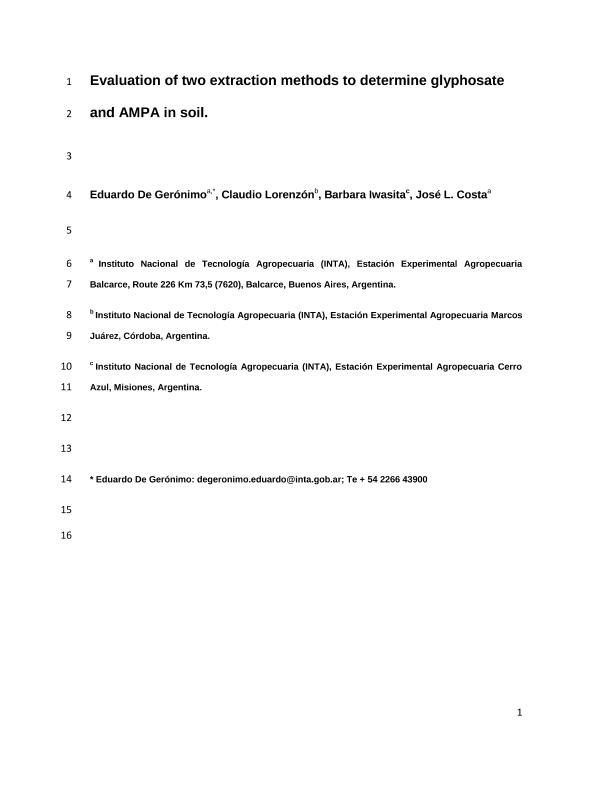Mostrar el registro sencillo del ítem
dc.contributor.author
de Gerónimo, Eduardo

dc.contributor.author
Lorenzón, Claudio
dc.contributor.author
Iwasita, Bárbara

dc.contributor.author
Costa, José L.
dc.date.available
2020-04-01T19:41:45Z
dc.date.issued
2018-07
dc.identifier.citation
de Gerónimo, Eduardo; Lorenzón, Claudio; Iwasita, Bárbara; Costa, José L.; Evaluation of Two Extraction Methods to Determine Glyphosate and Aminomethylphosphonic Acid in Soil; Lippincott Williams; Soil Science; 183; 1; 7-2018; 34-40
dc.identifier.issn
0038-075X
dc.identifier.uri
http://hdl.handle.net/11336/101572
dc.description.abstract
Modern agricultural technology is based on a package that combines direct seeding and glyphosate with transgenic crops (soybean, maize, and cotton). Because of widespread glyphosate use, it is important to assess its impact on the environment. However, glyphosate´s unique physicochemical characteristics make determination difficult at residue concentrations, especially in soils with high organic matter content, such as the soils from the central eastern region of Argentina, where strong analytical interferences are normally observed. The aim of this work was to compare the efficiency of two extraction methods of glyphosate using representative soils from Argentina. One method is based on the use of a phosphate buffer as the extracting solution and dichloromethane to minimize matrix organic content. The other method uses potassium hydroxide for the soil extraction of analytes and involves a cleanup step using solid phase extraction to minimize analytical interferences. Both methodologies involve a derivatization with 9-fluorenyl-methyl-chloroformate in borate buffer, the use of isotope labeled glyphosate as an internal standard, and detection based on ultrahigh-performance liquid chromatography coupled to tandem mass spectrometry. Recoveries obtained for soil samples spiked at 100 and 1000 μg kg−1 were satisfactory in both methods (70%?120%). However, significant differences were observed in the effects on the organic matrix. The solid phase extraction cleanup step was insufficient to remove the interferences, whereas the dilution and the cleanup with dichloromethane were more effective in minimizing the ionic suppression.
dc.format
application/pdf
dc.language.iso
eng
dc.publisher
Lippincott Williams

dc.rights
info:eu-repo/semantics/openAccess
dc.rights.uri
https://creativecommons.org/licenses/by-nc-sa/2.5/ar/
dc.subject
Glyphosate
dc.subject
AMPA
dc.subject
Soil
dc.subject
Ultra-performance Chromatography
dc.subject
Matrix effects
dc.subject.classification
Química Analítica

dc.subject.classification
Ciencias Químicas

dc.subject.classification
CIENCIAS NATURALES Y EXACTAS

dc.title
Evaluation of Two Extraction Methods to Determine Glyphosate and Aminomethylphosphonic Acid in Soil
dc.type
info:eu-repo/semantics/article
dc.type
info:ar-repo/semantics/artículo
dc.type
info:eu-repo/semantics/publishedVersion
dc.date.updated
2020-03-25T14:01:31Z
dc.journal.volume
183
dc.journal.number
1
dc.journal.pagination
34-40
dc.journal.pais
Estados Unidos

dc.description.fil
Fil: de Gerónimo, Eduardo. Instituto Nacional de Tecnología Agropecuaria. Centro Regional Buenos Aires Sur. Estación Experimental Agropecuaria Balcarce. Área de Investigación en Agronomía; Argentina. Consejo Nacional de Investigaciones Científicas y Técnicas; Argentina
dc.description.fil
Fil: Lorenzón, Claudio. Instituto Nacional de Tecnología Agropecuaria. Centro Regional Córdoba. Estación Experimental Agropecuaria Marcos Juárez; Argentina
dc.description.fil
Fil: Iwasita, Bárbara. Instituto Nacional de Tecnologia Agropecuaria. Centro Regional Misiones. Estacion Experimental Agropecuaria Cerro Azul. Agencia de Extension Rural Apostoles.; Argentina
dc.description.fil
Fil: Costa, José L.. Instituto Nacional de Tecnología Agropecuaria. Centro Regional Buenos Aires Sur. Estación Experimental Agropecuaria Balcarce. Área de Investigación en Agronomía; Argentina
dc.journal.title
Soil Science

dc.relation.alternativeid
info:eu-repo/semantics/altIdentifier/doi/http://dx.doi.org/10.1097/SS.0000000000000225
dc.relation.alternativeid
info:eu-repo/semantics/altIdentifier/url/http://agris.fao.org/agris-search/search.do?recordID=US201900249225
Archivos asociados
